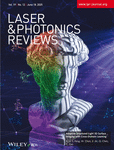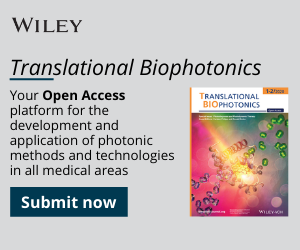Journal list menu
Export Citations
Download PDFs
Front Cover
Adaptive Structured-Light 3D Surface Imaging with Cross-Domain Learning (Laser Photonics Rev. 19(12)/2025)
- First Published: 17 June 2025
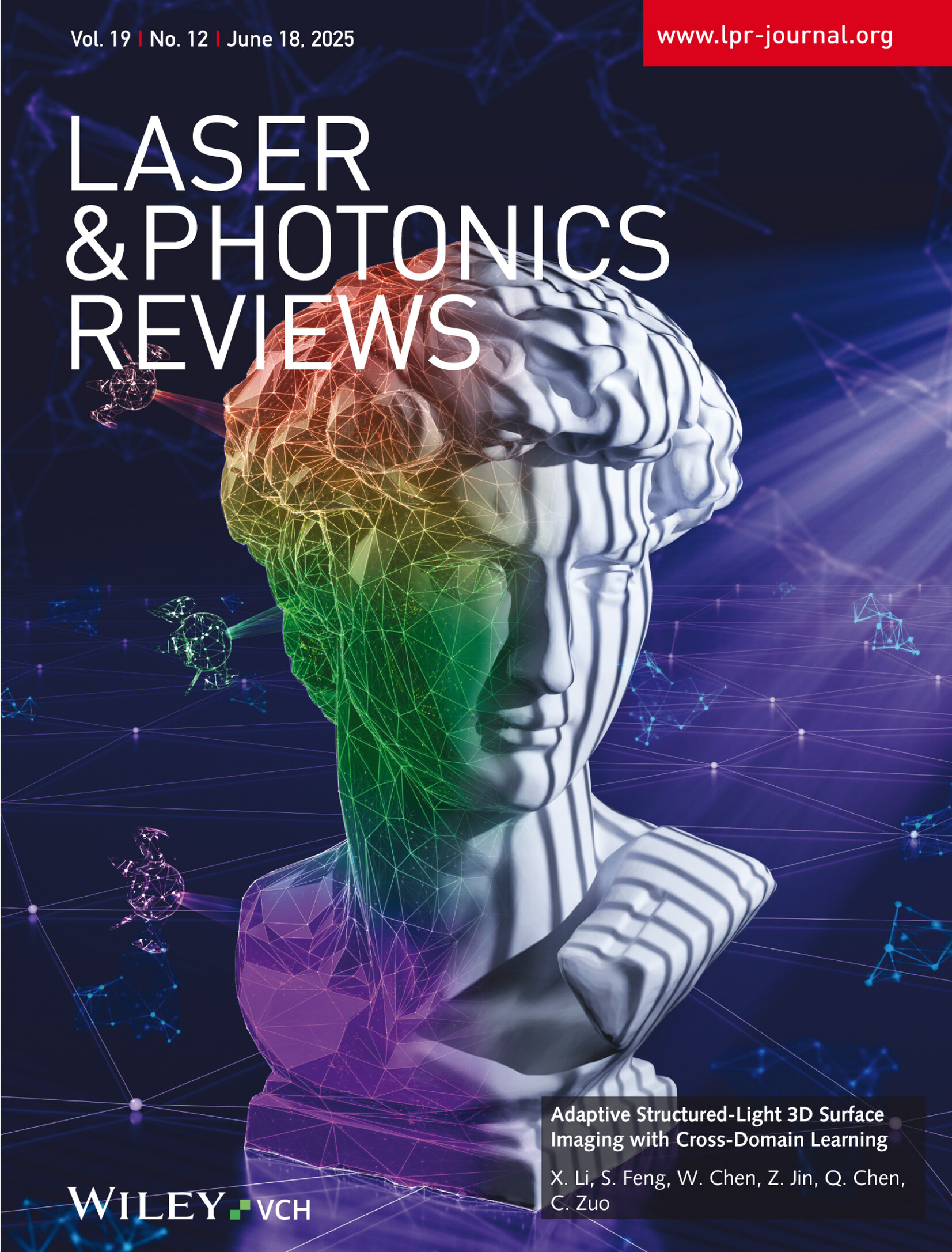
Enhancing Structured-Light 3D Imaging
A cross-domain learning framework for adaptive structured-light 3D imaging is proposed by Shijie Feng, Qian Chen, Chao Zuo, and co-workers in article number 2401609; it enhances generalization across diverse systems and environments. The method incorporates a mixture-of-experts architecture, significantly improving performance over traditional specialist and generalist DNNs, and advancing robust AI-driven optical metrology.
Inside Front Cover
Monolithic Spin-Multiplexing Metalens for Dual-Functional Imaging (Laser Photonics Rev. 19(12)/2025)
- First Published: 17 June 2025
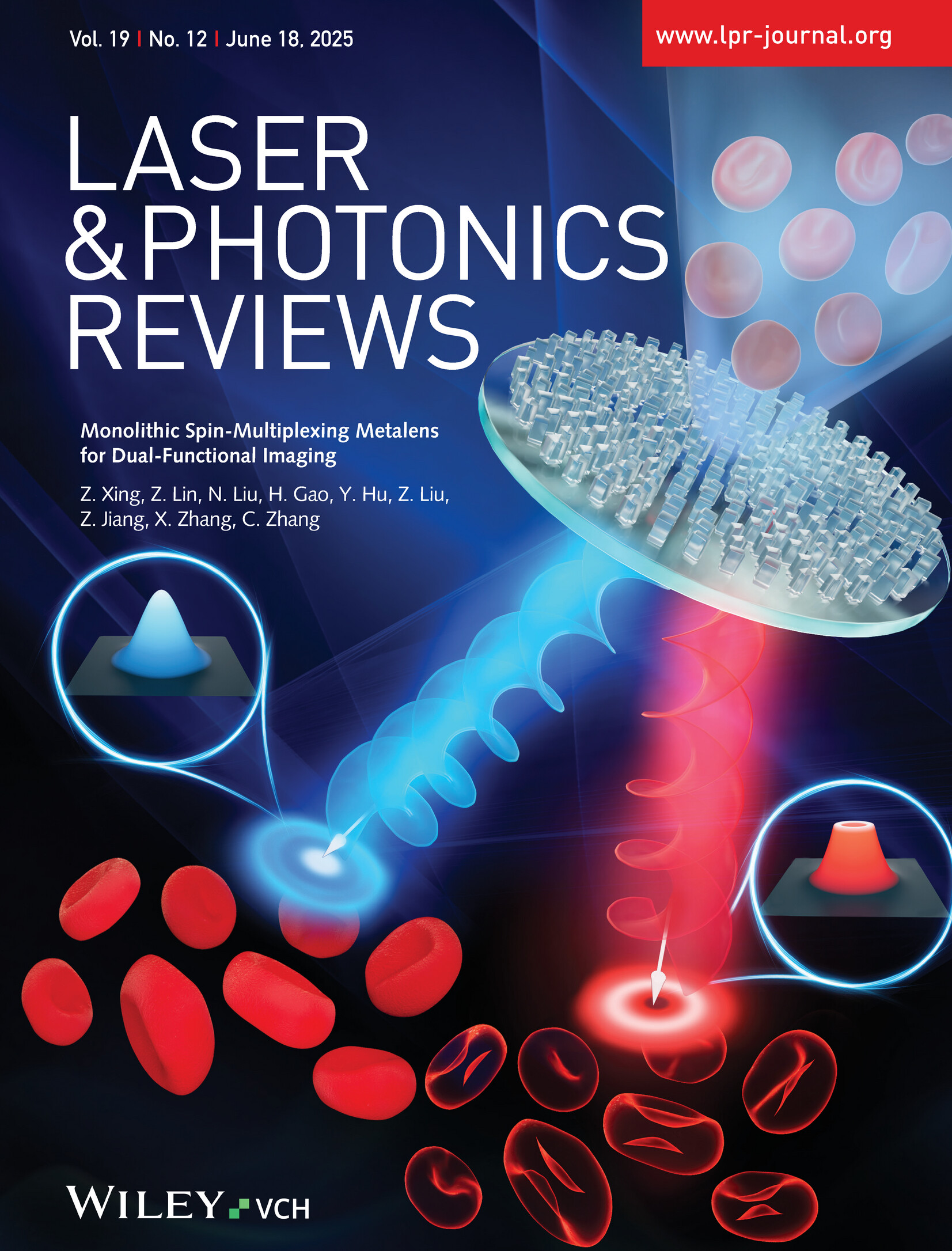
Dual-Functional Imaging Metalens
The cover image showcases a monolithic metalens with dual-functional imaging capabilities. As revealed by Zeyang Liu, Cheng Zhang and co-workers in article number 2401993, when illuminated with left-handed circularly polarized (LCP) light, the device generates an Airy-disk-shaped point spread function, enabling diffraction-limited bright-field imaging. In contrast, under right-handed circularly polarized (RCP) light, the metalens produces a donut-shaped point spread function, facilitating isotropic edge-enhanced imaging. This innovative design offers a compact, lightweight, and easily switchable solution for multi-functional microscopic imaging systems.
Back Cover
Highly Bright Silicon Nanocrystal White Light-Emitting Diodes With Luminance in Excess of 10000 cd m⁻2 (Laser Photonics Rev. 19(12)/2025)
- First Published: 17 June 2025
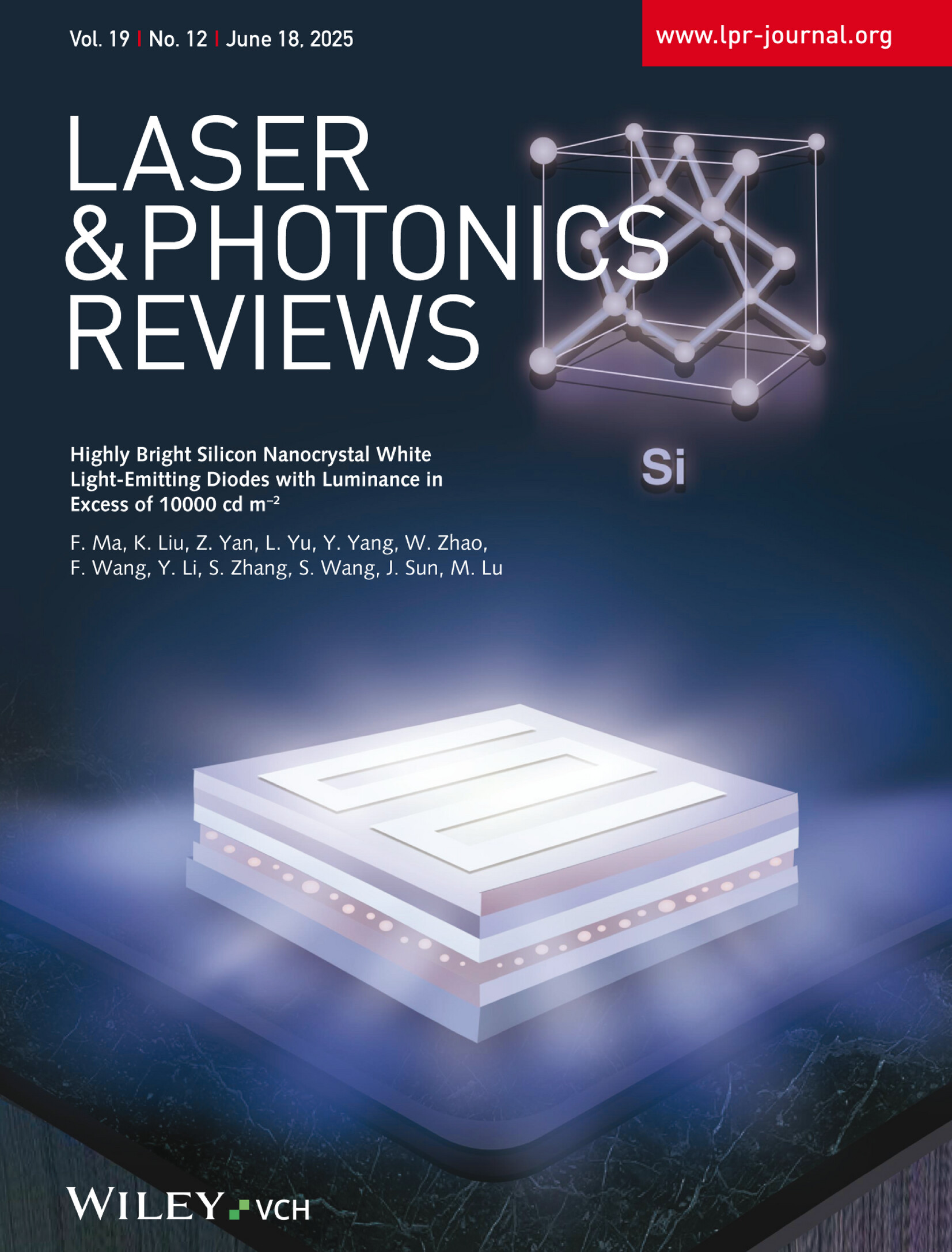
Bright Si LED
The cover image depicts a highly bright silicon nanocrystal white light-emitting diode with luminance in excess of 10000 cd m−2. Through optimizing the passivation of the active layer and the texturing of the substrate, the luminance has reached 10751 cd m−2. When a Peltier cooler is further used, the luminance reaches 12363 cd m−2. For more details, see article number 2402164 by Ming Lu and co-workers.
Issue Information
Review
Deconvolution Techniques in Optical Coherence Tomography: Advancements, Challenges, and Future Prospects
- First Published: 15 April 2025
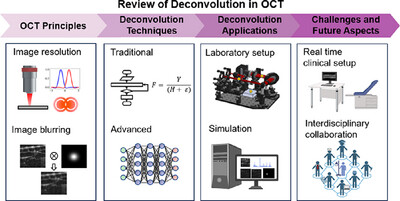
This review explores deconvolution techniques in optical coherence tomography (OCT), addressing resolution degradation from point-spread functions (PSF). It reviews foundational principles (e.g., Richardson-Lucy deconvolution) to advanced AI-driven methods, emphasizing clinical translation and interdisciplinary collaboration. Real-world implementations necessitate robust, real-time solutions to advance OCT diagnostics.
Interfacial Molecular Engineering of Rare Earth-Doped Nanocrystals: Basic Principles, Construction Strategies, and Advanced Applications
- First Published: 23 April 2025
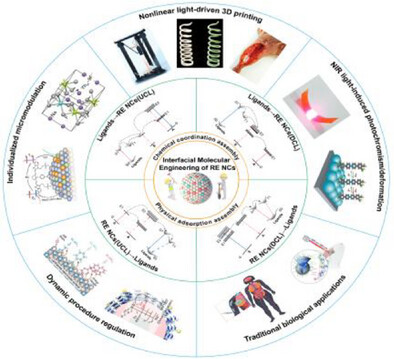
A comprehensive and timely update on recent advances in interfacial molecular engineering of rare earth-doped nanocrystals, including crucial theoretical knowledge, construction protocols, advanced applications, and future directions is provided. This strategy is able to integrate individual strengths and shows exciting functionalities. It is hoped that this review will be of great interest to researchers in the field of functional nanomaterials.
Research Article
Adaptive Structured-Light 3D Surface Imaging with Cross-Domain Learning
- First Published: 06 January 2025

A cross-domain learning framework for adaptive structured-light 3D imaging is proposed, enhancing generalization across diverse systems and environments. The method incorporates a novel mixture-of-experts architecture, significantly improving performance over traditional specialist and generalist DNNs, and advancing robust AI-driven optical metrology.
Monolithic Spin-Multiplexing Metalens for Dual-Functional Imaging
- First Published: 31 January 2025
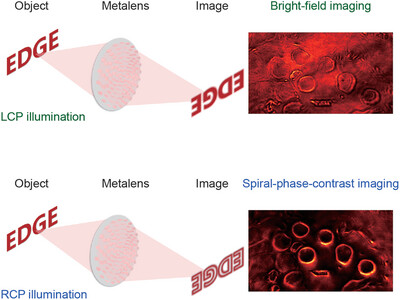
A monolithic photonic spin-multiplexing metalens enables seamless switching between bright-field and spiral-phase-contrast imaging modes by simply adjusting the spin state of illumination light. The device achieves an operational efficiency up to 80% and imaging resolution better than 4.4 µm (228 lp mm−1) in both modes. This study provides a viable solution for compact, lightweight, and easily switchable multi-functional microscopic imaging systems.
Highly Bright Silicon Nanocrystal White Light-Emitting Diodes With Luminance in Excess of 10000 cd m⁻2
- First Published: 18 February 2025
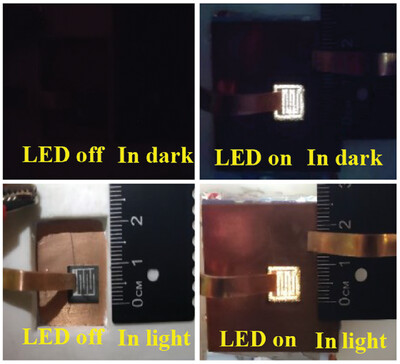
This current research has resulted in a highly bright silicon nanocrystal white light-emitting diode (WLED) with luminance exceeding 10000 cd m⁻2. The passivation of the active layer and the texturing of the substrate are optimized, achieving a maximal luminance of 10751 cd m⁻2. When a Peltier cooler is introduced, the luminance further increases to 12363 cd m⁻2.
Ultrathin Lanthanide-Based Metal-Organic Nanosheets with Thickness- and Temperature-Driven Light Emission
- First Published: 06 March 2025
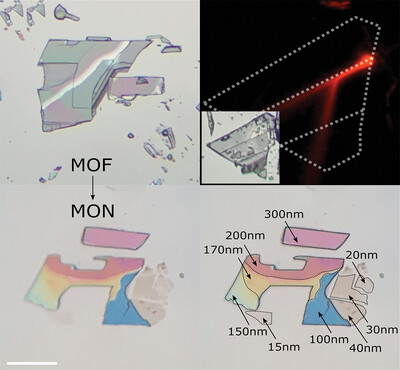
Exfoliation of photoluminescent 2D MOFs into metal-organic nanosheets with a thickness of up to 13.5 nm results in a 10–50 fold increase of PL intensity. The discovered nonlinear thickness- and temperature-driven PL of 2D MOF allows the creation of efficient, robust, and ultrathin light sources and optical sensors of the temperature.
Dual-Mode Photodetectors Mimicking Retinal Rod and Cone Cells for High Dynamic Range Image Sensor
- First Published: 06 March 2025
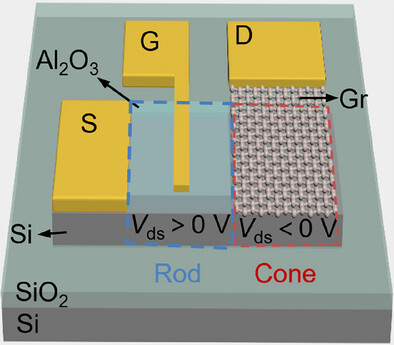
A novel dual-mechanism photodetector mimicking the bionic vision sensor is reported, achieving complementary versatility akin to cone and rod cells in diverse lighting scenarios through silicon-on-insulator and graphene heterostructures. Under reverse bias, the device functions as a cone cell in photodiode mode, while under forward bias, it transitions to photoconductor mode, mimicking the behavior of a rod cell.
Active Broadband Terahertz OAM-Based Metalens Based on Multi-Channel Multiplexing
- First Published: 08 March 2025
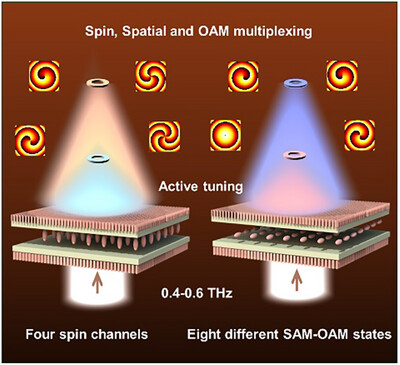
A new electrically controlled multi-channel multiplexing strategy uses cascaded helical geometric metasurface, liquid crystal (LC) layer, and orbital angular momentum (OAM)-based metalens independently manipulate phases across all four spin channels. By employing spin, spatial, and OAM multiplexing, along with the dynamic control mechanism for LC orientation, it decodes eight distinguishable spin angular momentum (SAM)-OAM coupling states, enabling dynamic control of THz vortex beams with six topological charges.
Tailoring of Blue-Cyan Luminescence in Rb3Y[(P1-xSix)O4]2:Eu2+ Phosphor via Si4+-P5+ Heterovalent Substitution for Full-Spectrum Healthy Lighting
- First Published: 08 March 2025
![Tailoring of Blue-Cyan Luminescence in Rb3Y[(P1-xSix)O4]2:Eu2+ Phosphor via Si4+-P5+ Heterovalent Substitution for Full-Spectrum Healthy Lighting](/cms/asset/82ee07ca-3dfe-4e31-9dec-e46f6a4cc213/lpor202500026-gra-0001-m.jpg)
The luminescence from blue-violet to blue-cyan in Rb3Y(PO4)2:Eu2+ phosphor is successfully modulated by Si4+-P5+ heterovalent ion substitution. By replacing the blue-violet-emitting phosphor with the blue-cyan-emitting phosphor as the blue component in white light-emitting diodes, the color rendering index can be enhanced from 90 to 97.2, highlighting the essential role of blue-cyan phosphors in full-spectrum healthy lighting.
Full-Stokes Spectro-Polarimetric Camera with Full Spatial Resolution
- First Published: 09 March 2025
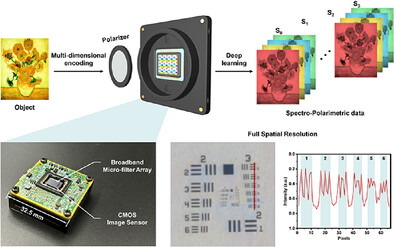
By employing a CMOS-compatible micro-filter array and a deep unfolding network (GAP-net), a spectro-polarimetric camera is proposed that integrates full-Stokes polarimetric imaging and multi-spectral imaging. Characterization using the USAF 1951 test chart demonstrates a resolution of 14.30 lines per millimeter, comparable to the performance of commercial CMOS image sensors.
Predicting VCSEL Emission Properties using Transformer Neural Networks
- First Published: 09 March 2025
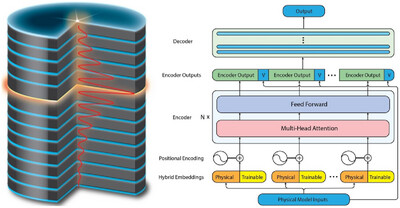
This study presents an innovative approach to predicting VCSEL emission characteristics using transformer neural networks. It is demonstrated how to modify the transformer neural network for applications in physics. This model trains faster and predicts more accurately compared to conventional neural networks. The transformer architecture also suitable for applications in other fields is proposed. A demo is available at https://abelonovskii.github.io/opto-transformer/.
Exceptionally High Nonlinear Optical Response in Two-dimensional Type II Dirac Semimetal Nickel Di-Telluride (NiTe2)
- First Published: 10 March 2025
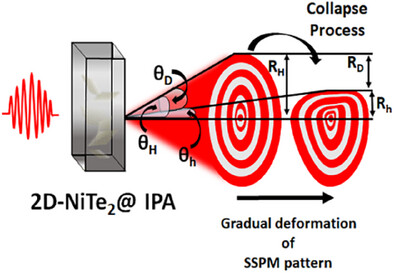
A diode that rectifies light: The 2D-NiTe2 is analyzed using SSPM spectroscopy to investigate its nonlinear optical characteristics. Key parameters such as the nonlinear refractive index and third order nonlinear susceptibility are computed. The discussion focuses on the evolutionary and distorted nature of the diffraction pattern of the SSPM. A nonlinear photonic diode is created utilizing the SSPM spectroscopy approach.
Terabit-Per-Second Multidimensional Multiplexing Photonic Integrated Circuit in Lithium Niobate on Insulator
- First Published: 11 March 2025
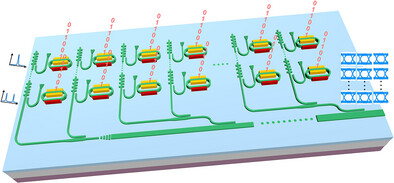
A multidimensional multiplexing photonic integrated circuit is proposed and experimentally demonstrated in lithium niobate on an insulator (LNOI) platform, which shows an impressive total data communication rate of 0.96 Tbps. This work provides an effective solution for future large-capacity optical communication networks.
Unveiling the Dynamics of Frenkel Defects in Fluoride Materials for X-Ray-Induced Persistent Luminescence and Advanced Imaging Applications
- First Published: 11 March 2025
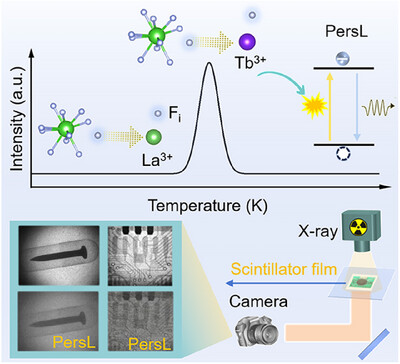
This study explores the mechanism behind X-ray-induced persistent luminescence (PersL) in fluoride materials consisting solely of fluoride and lanthanide ions. It uncovers that Frenkel defects possess dynamic and recoverable characteristics, categorized into two types depending on the localization of interstitial fluoride ions. These insights enhance the understanding of PersL mechanisms and propel the advancement of X-ray PersL imaging technology.
Realization of a Photonic Higher-Order Double-Weyl Semimetal
- First Published: 11 March 2025
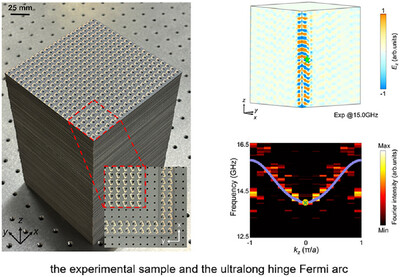
A novel higher-order double-Weyl semimetal is experimentally realized in a 3D photonic metamaterial for the first time. It is shown that the unconventional higher-order double Weyl points have larger chiral charges of ±2, achieving an unprecedently ultralong hinge Fermi arc spanning the entire Brillouin zone. Moreover, using microwave near-field measurements, the Fermi-arc surface states and topological hinge states in the photonic higher-order double Weyl semimetal are directly observed. This work significantly extends the research scope of higher-order Weyl semimetals and offers an ideal photonic platform for exploring topological Weyl physics.
Full-Space Spin-Controlled Four-Channel Metalens With Equal Power Distribution and Broad Bandwidth
- First Published: 12 March 2025
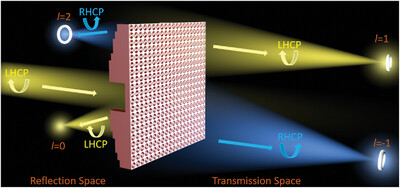
In article xxxxx, Alex M. H. Wong and co-authors propose a multifunctional full-space metalens supporting power-efficient, broadband operation for four spin-controlled output channels. The metalens separates an incoming wave into four equi-power, spin-decoupled and function-decoupled waves (two transmitted and two reflected). Such multifunctional metalenses can find strong applications in millimeter-wave imaging and communication systems.
Tailoring Self-Trapped Exciton Emission in 0D Indium-Based Perovskites by Solvent-Induced Crystal Structure Engineering
- First Published: 12 March 2025
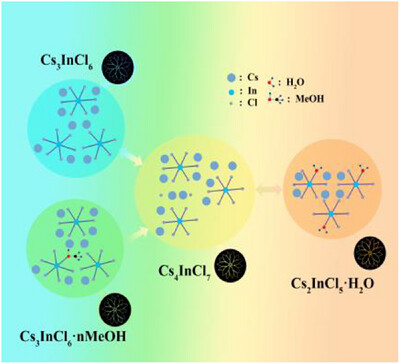
The reversible phase transformations have been realized between 0D Cs4InCl7, Cs2InCl5·H2O, and Cs3InCl6 triggered by a solvation-like effect. The systematic studies reveal that low charge symmetry of octahedron, which favors the charge localization in excited states, is responsible for strong second-order Jahn-Teller distortion for tunable self-trapped exciton emissions toward broad applications.
Vectorial Beams With Longitudinally Varying Polarizations Generated by Surface-Wave Metasurfaces
- First Published: 13 March 2025
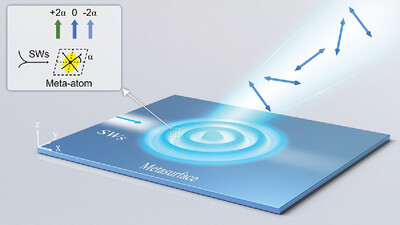
In this paper, an efficient far-field vectorial beam with longitudinally varying polarizations under surface-wave excitation is demonstrated. The polarization of the radiated fields can be arbitrarily tuned by adjusting the phase difference of two decoupled orthogonal fields via a composite arrangement of meta-atoms. Experimental results confirm the proposed concept and theory.
Visible Phase-Locked Microcombs Generation in High-Index Doped Silica Glass Micro-Ring Resonators
- First Published: 13 March 2025
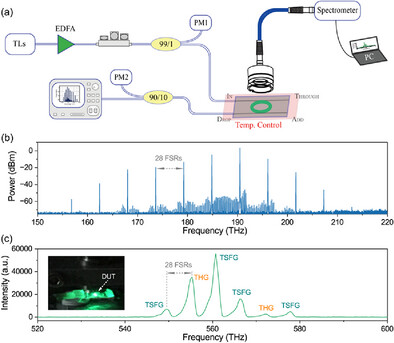
The development of visible light integrated microcombs has attracted significant interest. However, achieving a visible phase-locked microcomb remains challenging. Visible phase-locked microcombs are successfully demonstrated by converting a near-infrared soliton crystal microcomb in a high-index doped silica glass micro-ring resonator. Two-color (green-NIR) and tri-color (green-red-NIR) phase-locked microcombs are produced by the combined Pockels and Kerr parametric processes.
Dynamic Multi-Focus 3D Laser Nanoprinting Based on Two-Step Absorption and Computational Holography
- First Published: 13 March 2025

Low single-focus laser powers in two-step-absorption 3D laser nanoprinting make parallelization efforts a viable route to increase print speeds while still relying on compact continuous-wave lasers. Herein, an established two-step-absorption photoresist system with computational holography based on a digital micromirror device is combined in order to demonstrate a dynamic multi-focus 3D laser nanoprinting approach.
Spatio-Spectral Customized Light Structures for Subwavelength Highly Resolved Multiplexing of Diffractive Optics
- First Published: 15 March 2025
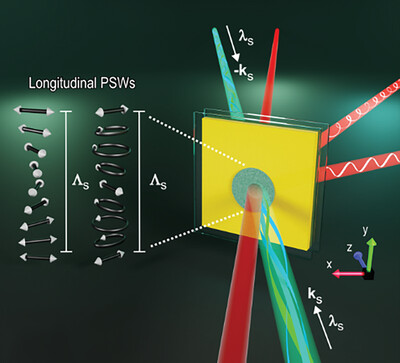
Polarization standing waves (PSWs) created by broadband counter-propagating light beams offer a flexible and efficient method for encoding complex and customizable structures in photosensitive materials with finely tunable periodicities and nanometric resolution. Crosstalk-free multiple polarization volume gratings with subwavelength periodicities are recorded in a single-step process. This method opens unexplored opportunities for scalable, high-resolution applications in cutting-edge optical technologies.
Reprogrammable Vector Optical Field Meets Planar Liquid Crystal Elements for Enhanced Security in Holography
- First Published: 16 March 2025
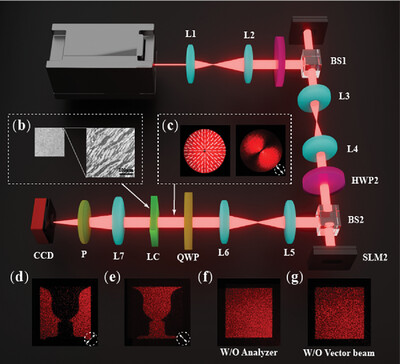
This work integrates traditional vector holographic encryption with vector optical field, distributing secret information among multiple carriers, including vector optical field, LC device, and analyzer. By leveraging the reprogrammable properties of the incident light's vector information, the proposed method enables multi-channel vector encryption holography, enhancing security and flexibility in optical information encryption.
Refraction and Coupling of Topological Edge State Based on Silicon Valley Photonic Crystals
- First Published: 17 March 2025
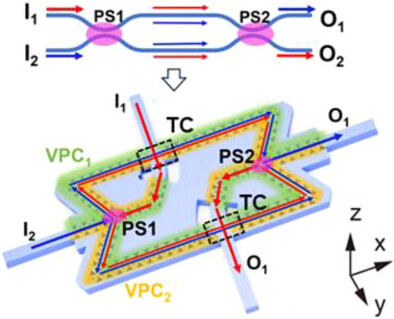
The refraction mechanisms of topological edge modes at different external coupling boundaries are investigated and a compact and low-loss waveguide crossing for configurable topological interconnections is proposed. To demonstrate practical applications, a compact 2 × 2 topological switch that utilizes the topological crossing and a topological Mach-Zehnder interferometer (MZI) structure is demonstrated.
Spin-Deposited Ruddlesden–Popper Polycrystalline Perovskites for Large-Area High-Sensitivity Filterless Narrowband Photodetectors with Ultrafast Response Speed
- First Published: 17 March 2025
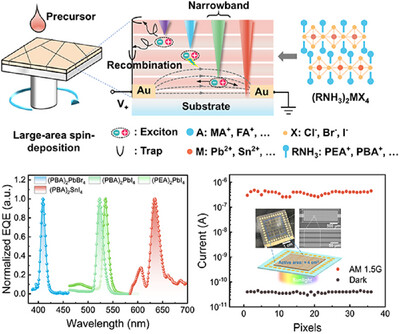
Photoconductive filterless perovskite narrowband photodetectors (PNPDs) with record high detectivity and ultrafast response speed are constructed with spin-deposited polycrystalline 2D Ruddlesden–Popper perovskite films, with the photodetection properties being finely tuned by the spacer cation. A low-cost high-quality large-area PNPD array is further demonstrated for precise color and shape discrimination, which sheds light to the practical applications of PNPDs.
Manipulation of Plasmonic Oxide Inside Transparent Matrices for Boosting Infrared Optical Nonlinearity and Ultrafast Optical Switching
- First Published: 18 March 2025
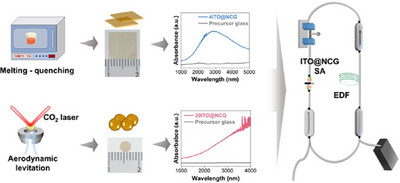
Plasmonic indium tin oxide (ITO) nanoparticles (NPs) are controllably precipitated in inorganic oxide glasses via solid-state reaction. The localized surface plasmon resonance of ITO NPs results in boosted infrared nonlinear optical response with a response time down to 100-fs scale, which enables diverse applications, as exemplified here by optical switching for mode-locked pulse generation in fiber lasers.
Polarization-Stable Wavelength-Tunable Single-Mode Vertical-Cavity Surface-Emitting Lasers with a Monolithic High-Refractive-Index-Contrast Grating Top Coupling Mirror
- First Published: 18 March 2025
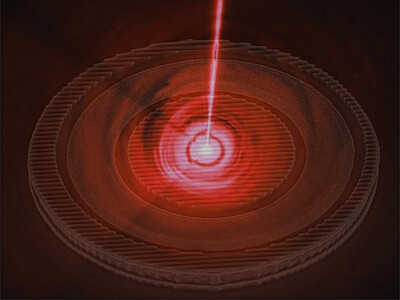
The study presents the latest results on single-mode VCSELs with record current induced wavelength tuning using a grating structure as part of the top coupling mirror. The grating structure is monolithically integrated using only one fabrication layer and provides mono linearly polarized emission as well as supreme side-mode suppression such that single-mode emission is maintained up oxide apertures diameters of 7 µm.
Enhanced Radiation Hardness of InAs/GaAs Quantum Dot Lasers for Space Communication
- First Published: 18 March 2025
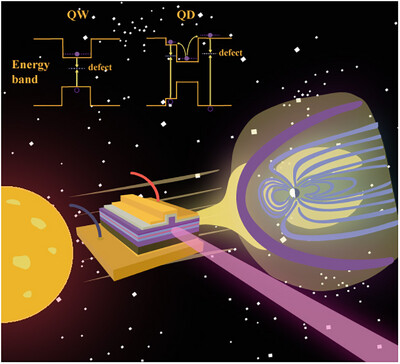
InAs/GaAs quantum dot (QD) lasers with QD filling factors exceeding 50% exhibit enhanced radiation hardness and a near-zero linewidth enhancement factor (LEF). They demonstrate an exceptional relative intensity noise (RIN) of -162 dB Hz−1, with an increase of only 1 dB Hz−1 under proton irradiation. Additionally, these lasers maintain stability under strong optical feedback, highlighting their potential for reliable space laser communication.
High-Performance Colloidal Quantum-Dot VCSEL with Quality Factor Above 2000
- First Published: 18 March 2025
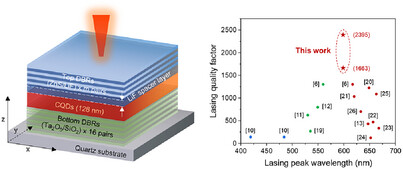
This study presents high-performance colloidal quantum-dot VCSELs with a record-breaking lasing quality factor of 2395 and a low threshold of 58 µJ cm−2. The achievement is attributed to the development of engineered CQDs with sub-single-exciton gain threshold and a high-quality VCSEL cavity fabricated using low-temperature thermal evaporation, ensuring precise control and high reflectivity without compromising the optical properties of the CQDs.
Near-Unity and Near-Zero-Thermal-Quenching Luminescent GAGG–Al2O3:Cr3+ Ceramic via Containerless Solidification and Glass Crystallization Methods for NIR Spectroscopy Application
- First Published: 18 March 2025
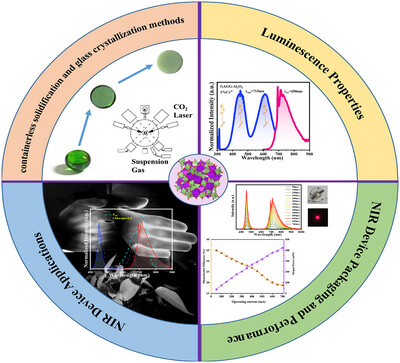
A novel Gd3Al3Ga2O12 (GAGG)–Al2O3:Cr3+ ceramic with near-unity internal quantum efficiency (IQE) and exceptional thermal stability is synthesized via containerless solidification and glass crystallization methods. Exhibits outstanding photoelectric-conversion efficiency and watt-level near-infrared (NIR) output. These advancements pave the way for high-performance NIR LED&LD devices, unlocking transformative applications in bioimaging, nondestructive testing, plant illumination, and advanced night vision technologies.
Multiplexed Holography Using Spiral Fractional Orbital Angular Momentum
- First Published: 18 March 2025
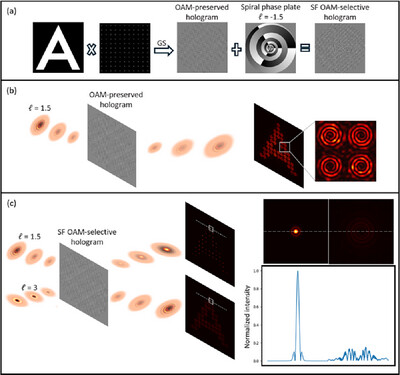
In order to enhance the information capacity and security of OAM multiplexed holography, a novel holography based on spiral-fractional OAM modes, which can be randomly selected to inherently serve as independent channels without any other parameter restrictions and with virtually no cross-talk present, is proposed. The feasibility of the scheme is experimentally demonstrated.
High-Performance and Low-Cost Gradient Refractive Index Films for Ultra-Broadband and Ultra-Wide Angle Antireflective Applications
- First Published: 19 March 2025
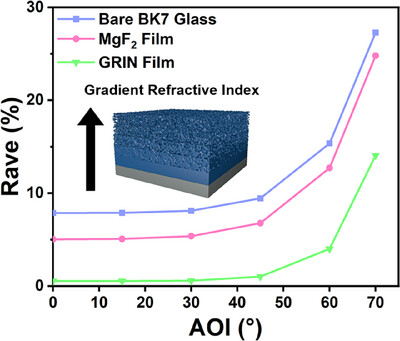
This study presents an innovative approach for fabricating gradient refractive index (GRIN) nanoporous silica films on glass substrates using a combination of magnetron sputtering and selective wet etching. The resulting films demonstrate excellent ultra-wideband and wide-angle antireflective properties, high reproducibility, and strong environmental stability. Furthermore, it is shown that these GRIN films have significant potential to enhance the energy efficiency of solar cells.
Bendable Fiber Lens for Minimally Invasive Endoscopy
- First Published: 18 March 2025
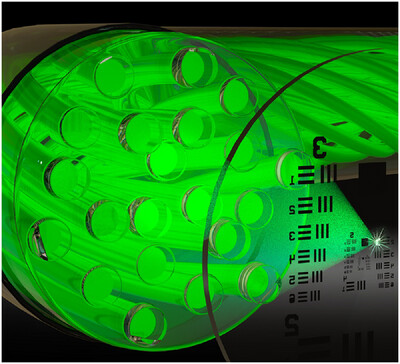
Translating ex vivo imaging to minimally invasive in vivo applications is of outstanding scientific and socioeconomic relevance. 3D imaging based on tiny lensless fiber endoscopes requires complex setups and computational schemes, so far. Bridging this gap, imaging through a unique optical fiber that mimics the functionality of a lens but is minimally invasive and resilient to bending is demonstrated.
Generation of Arbitrary Vector Vortex Beam Using a Single Q-Plate
- First Published: 17 March 2025

This work proposes a method for generating arbitrary vector vortex beams (VVBs). Simultaneous manipulation of the phase and polarization distributions of beams is implemented by one q-plate. A phase delay system constituted of conventional optical elements is presented to realize the polarization evolution of VVBs. VVBs with phase and polarization topological charges of up to 16 are generated experimentally.
Functional Multispectral Camouflage Strategy Based on Flexible Transparent Metamaterial Compatible with Radiative Cooling
- First Published: 19 March 2025
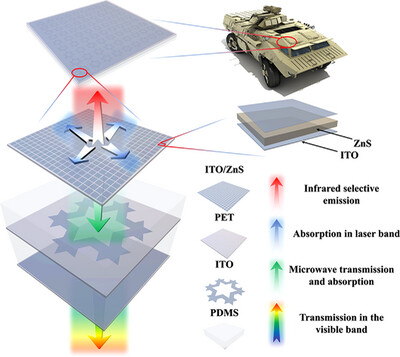
Novel flexible multispectral camouflage strategy based on multiscale-hierarchical design and compatible for visible, laser, infrared, and microwave with radiative cooling, which offers the advantages of simple preparation process, cost-effectiveness, surface conformal capability, effective multispectral camouflage performance.
Defect-Assisted Dual-Channel Optical Storage Material with Photochromism and Concealed Persistent Luminescence
- First Published: 19 March 2025
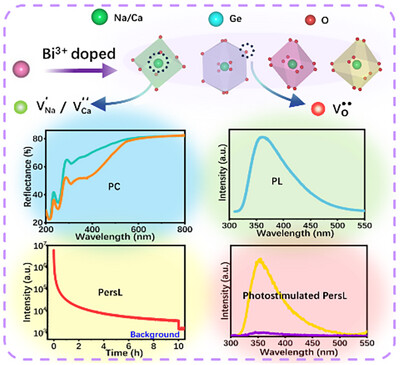
The Na2CaGe2O6:Bi3+ material undergoes a color transition from white to brown under 254 nm light and exhibits ultraviolet persistent luminescence (PersL) for over 10 h after the light source is switched off. Additionally, the phosphor can revert to its original color and the PersL performance can be significantly enhanced by 425 nm light or thermal treatment.
Ultra-Efficient Passive Daytime Radiative Cooling Enabled by Dual-Selective Inorganic SiO2/Si3N4 Photonic Emitter
- First Published: 20 March 2025
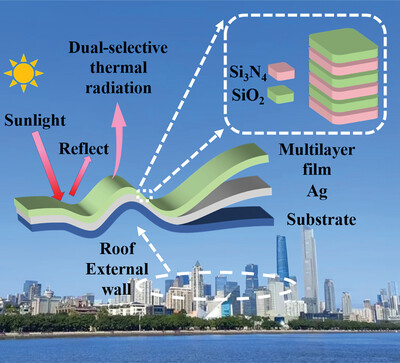
Radiative cooling enables daytime subambient temperature with zero-energy cost. To maximize the cooling potential and address current deteriorating issues, a dual-selective emitter is developed using an inorganic SiO2/Si3N4 photonic structure. It exploits the often-overlooked secondary atmospheric window to achieve significant daytime subambient cooling (up to 12.6 °C). This work provides an effective and sustainable radiative cooling solution with superior performance.




